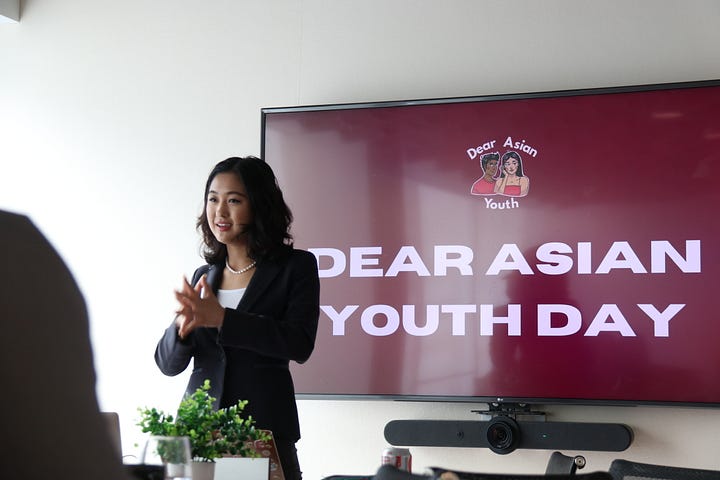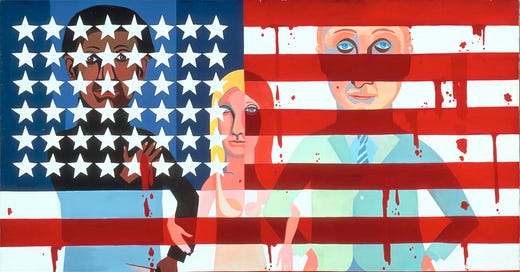Blood in The Ledger: From Slave Markets to Stock Portfolios
From slavery-backed banks to finance-bound seniors, the pipeline is still soaked in power and profit.
“You have to stand up for what you believe in, even if it means going against the norm.”
— Faith Ringgold
Six figures. Free dinners. Private equity parties on yachts.
That’s what they don’t tell you during freshman orientation — that Harvard’s most seductive curriculum isn’t in a classroom.
It’s a pipeline. A well-oiled machine that turns dreamy, service-minded students into consultants by age 22.
You come in wanting to change the world, and you leave knowing how to change a slide deck by Monday.
Some call it prestige. I call it a funnel — and if you're not careful, it will swallow your purpose whole.
This isn’t just about Harvard. It’s about what we, as a society, are told to value. Who gets to serve? Who gets to create? Who gets to cash out? And at what cost?
In this essay, I want to trace that cost, from the slave-backed banks of early Wall Street to the “golden handcuffs” gripping today’s graduates.
I want to explore how the arts, service, and storytelling are still considered luxuries, even as the world burns and bleeds. And I want to ask a dangerous question:
What if success wasn’t a salary, but a legacy?
Let’s begin.
Service vs. Salary: Harvard’s Career Pipeline
Before Harvard was synonymous with hedge funds and case competitions, it produced architects of both policy and resistance.
In the mid-20th century, names like John F. Kennedy symbolized a national call to service — a time when civic duty was still seen as a noble pursuit. But long before that, in 1895, W.E.B. Du Bois became the first Black American to earn a Ph.D. from Harvard — not to be accepted, but to confront. His life’s work challenged the very foundation of the institution, demanding that scholarship serve liberation, not just legacy.
Harvard has always been a contradiction: the training ground for presidents, and for protestors. We inherit both lineages. The question is: which one are we here to extend?
Fast-forward to Harvard College today: many students arrive inspired by service and the arts, but most end up on a different path.
Recent data shows that 40% or more of Harvard seniors now enter business, consulting, or finance, while under 4% enter public or nonprofit service. In fact, Harvard’s career survey reports that about 70% of seniors expect to work in the private sector (with roughly 41% in consulting/finance).
Those numbers are the reverse of what they were a few decades ago, when a majority of graduates chose government, teaching, or non‑profits. Today, by sophomore year, many students have already accepted internship offers with banks or law firms, creating a pipeline that locks them in early.

This pipeline is fueled by the promise of six-figure salaries and “golden handcuffs” – the idea that you can’t afford to quit once you earn top pay. As one BBC report describes, workers on Wall Street or in Big Tech often stay in jobs they hate just for the huge salary and perks.
In practice, a Harvard student on track for consulting or investment banking builds a resume so strong that leaving for a lower-paying job feels like too big a sacrifice – the handcuffs of tuition debt and market expectations grow tighter.
Many idealistic first-year students want nothing more than to go into public service, but by sophomore year, they have already taken finance internships and set their sights on Wall Street instead. The college's culture and incentives are pushing students into the highest-paying roles, even if their passions lie elsewhere.
The Streets We Walk
In 19th-century America, finance literally depended on slavery. Southern banks routinely took enslaved people as loan collateral and even auctioned them off when debts went unpaid.
JP Morgan Chase’s own predecessors later admitted to accepting thousands of slaves as collateral, ending up owning about 1,250 people between 1831 and 1865.
Even Manhattan’s stock market stands blocks from an old slave market, a reminder that New York’s financial success was built on the back of forced labor. This history shows that big banks and commerce were deeply entwined with slavery – northern merchants profited from Southern cotton, and insurers like Aetna and AIG sold slave-insurance policies. When we think of Wall Street, we should remember it was once literally banking on human bondage.

Market Reality: Finance Down, Arts Up?
But changing market trends are now challenging the notion that finance is the surest path to success. Major financial firms are cutting jobs.
In 2024, companies like PayPal, Citigroup, and Nasdaq announced thousands of layoffs as they “right-sized” after the low-rate boom. Even Wall Street stalwarts like BlackRock have trimmed staff. These mass cuts are a stark reminder that high finance can be volatile. By contrast, the cultural and creative sectors are showing surprising resilience.
A New York Fed report found that art history and philosophy majors currently face about 3% unemployment, whereas computer science and computer engineering majors face 6.1% and 6.7%, respectively. For example, UC Berkeley saw a 73% increase in arts and humanities freshmen over a decade, suggesting many young people are still drawn to creative fields despite the risks.

Even beyond unemployment statistics, anecdotal trends hint that skills in the arts, communications, or civic tech are in demand. As finance firms hedge for rainy days, businesses and nonprofits need people who can tell compelling stories, analyze social trends, and build community strengths, which are often found in arts and humanities graduates. Labor-market data are shifting.
What was once a “fail-safe” finance track shows signs of strain, while the path of service and creativity may be more viable than its reputation suggests. The flood of applications to art, English, and theater programs shows that many believe “creative industries” can flourish even when investment banks falter.
Sparking Change: The Harvard Civic Action Network
A new student initiative is trying to rewrite the narrative amid these contradictions. The Harvard Civic Action Network (HCAN), co-founded by Jack Sennott and I, launched an incubator model to empower service-oriented projects on campus. We founded HCAN to fight against the notion that pursuing service is something students can’t do.
Working with Harvard’s Democracy House, HCAN selects a cohort of student-led ventures each semester in areas like arts and culture, environmentalism, civic engagement, and humanitarian work. We provide funding, mentorship, and partnerships, essentially treating social impact ideas with the same seriousness and support that a startup or finance internship would get.
A Call, Not a Compromise
This didn’t start as a club or a committee. It started with a phone call and a refusal to settle.
Jack’s public service record runs deep—from managing operations at a sustainable oyster farm on Martha’s Vineyard to interning with Save Our Allies in Poland and working in Senator Ed Markey’s foreign policy office. In summer 2024, he earned a White House internship.
That fall, he took a leave from Harvard to organize full-time in Michigan on the Harris-Walz campaign. He led community outreach in Detroit and built coalitions across collegiate and Arab neighborhoods—knocking doors, managing teams, and moving real people to action.
I still remember his call to me in January 2024 — tired, fired up, and frustrated. He’d seen how many of our classmates, even the most justice-minded ones, were quietly accepting offers from McKinsey or Bank of America.
“They know it’s a money grab,” he said. “They’re just scared there’s no other way.” He told me he didn’t want to complain — he wanted to build. “I know you’re not going to sell out,” he said. “Let’s make something real.”
That call began the Harvard Civic Action Network — a space where public service isn’t the exception but the expectation.
What We’ve Built
We turned that conversation into something real — and raised $15,000 in our first term to prove it.
For example, in our first term, we raised $5,000 each for projects including an impact documentary on clean energy (“When America Mobilizes”), the Young Feminist Party, and Dear Asian Youth. Each project is paired with mentors (professors, alumni, and nonprofit leaders) who help turn a student’s idea into real-world change.




By incubating these projects, HCAN is directly disrupting Harvard’s career pipeline. It shows that art students, activists, and aspiring nonprofit leaders can practice their passions immediately, not after a ten-year detour through investment banking.
Why It Matters
Because service shouldn’t be a side hustle. It should be the infrastructure for a just future.
It also reframes service as innovative and interdisciplinary: one mentor, for instance, might guide a budding environmentalist on data analysis, while another helps a civic tech developer prototype an app. This model suggests that a commitment to social good need not be a fallback; it can be a highly supported, ambitious venture in its own right.
What If Service Were the Status Symbol?
What if we began to view a life of service, arts, and civic engagement as prestigious and glamorous, rather than “safe but boring” finance jobs? Imagine college not just as career training for the corporate world, but as a launchpad for changemakers.
For students at Harvard – or anywhere – the call to action is clear: ask yourself what impact you really want to make, not just how big a paycheck you can earn.
A startup can be socially driven, a documentary can be disruptive, and a voter-registration drive can be world-class entrepreneurship. If Wall Street’s chains were once built on slavery, let us ensure the new chains we forge are those of community and conscience.
Service can be ambitious. It can involve cutting-edge technology for clean energy, a compelling art installation on climate change, or a lucrative career directing a nonprofit. In a world facing climate crises, inequality, and democratic challenges, tackling these problems is the ultimate high-stakes game.
The Harvard Civic Action Network’s work hints at a future where “prestige” is measured by impact – how many lives you uplift, policies you change, and voices you amplify.
So, to all students and readers: reconsider what success looks like today. Does the prestige of a bank job outweigh the potential to lead a movement? Can “ambitious” describe someone starting a social enterprise, launching an arts collective, or organizing for justice?
Perhaps it’s time to flip the old script. Your white ancestors built fortunes on the backs of slaves – a grim legacy. We have the chance to build something better with our ambitions. Let’s make service and creativity just as glamorous and celebrated as corporate boardrooms once were.
Black Art Spotlight: Faith Ringgold’s The Flag is Bleeding (1967)
Faith Ringgold’s The Flag is Bleeding (1967) is one of the most powerful works of American art from the civil rights era. Ringgold, long celebrated for making art that documents the American narrative, visualizing its most uncomfortable chapters with a focus on race and gender, painted this canvas as the 1960s’ racial and political tensions were reaching a boiling point.
The late 1960s saw a wave of urban uprisings: Detroit (1967), Newark (1967), and other cities erupted in violence born of frustration with lived experience – racism, segregation, poverty, unemployment, and police mistreatment.
The Flag is Bleeding was painted toward the end of the American Civil Rights movement. It responds directly to those disturbances by showing America’s fabled banner literally bleeding over its citizens, asking whether a country divided by race and class can ever be truly united.
The U.S. flag becomes a cage and a shroud.
The Flag Never Stopped Bleeding: Race, Resistance, and the American Lie
Ringgold ties the nation’s symbol of liberty to the literal bloodshed faced by Black Americans. Her work draws on a lineage of Black artists who have confronted the American flag’s dual meaning: a cloth that can represent both freedom and subjugation.

In the same American People series, Ringgold had already been depicting American myths turned upside down—for example, American Dream (1964) shows a Black-and-white woman dangling a huge diamond over a downward-pointing arrow, suggesting that the pursuit of material wealth and superficial status leads to downfall.
The Flag is Bleeding continues that critique: the “American dream” looks attractive for some, while the dream seeps blood for others.
When Capital Bleeds: Institutions, Inequality, and the Price of Power
While The Flag is Bleeding emerged in the 1960s, its message resonates with today’s critiques of capitalism and institutional power. Ringgold’s painting shows how race and national identity intertwine; in the modern era, race and economic class are also deeply intertwined—a concept often called racial capitalism.
Racial capitalism is a system in which “racialized exploitation and capital accumulation are mutually reinforcing.” Ringgold’s bleeding flag can be a metaphor for this dynamic: the prosperity and “freedom” signaled by the flag come at the pain and sacrifice of marginalized people.
These ideas find echoes in today’s elite institutions. Top universities frequently funnel students into lucrative finance careers rather than public-service roles.
A recent study of Harvard’s campus describes a powerful “career funneling” dynamic where Wall Street firms run “status tournaments” recruiting students, causing many to see investment banking as the natural prize of their competitive climb.
Students and faculty complain that “money drives people’s careers at elite schools,” pushing young people to sideline civic goals in favor of wealth.
This concentration of talent has broad social effects. Redirecting top students into finance exacerbates inequality and even inflates systemic economic risk. Essential fields (education, science, public health) become “starved” of leadership and prestige.
Ringgold’s painting reminds us: this isn’t just a financial problem. It’s the same racial-economic hierarchy — just wearing a suit.
Today’s Wall Street is disproportionately populated by the privileged (often white) offspring of wealth. In fact, scholars observe that entry into high finance is still “largely saved for students who already come from the wealthiest backgrounds.”
Scholars observe that entry into high finance is still largely saved for students who already come from the wealthiest backgrounds.
A 2023 study published by the National Bureau of Economic Research found that 43 percent of white students admitted to Harvard were recruited athletes, legacies, children of faculty, or listed as potential donors — categories with overwhelmingly privileged profiles.
These admissions advantages further concentrate opportunity, ensuring that elite institutions reproduce inequality even before the first résumé is submitted.

Meanwhile, long-standing racial wealth gaps mean that Black Americans are far less likely to be part of that wealth class.
For example, in 1968, a Black household earned only about 63 cents for every dollar earned by a white household; by 2016, that figure was still only ~61 cents. Such disparities – the economic exclusion of Black communities – lie behind the flag’s bleeding stripes in Ringgold’s work.
Ringgold’s narrative from 1967 thus finds a modern echo in universities, corporations, and government spaces—literally where power, money, and race intersect. In these contexts, the American flag still symbolizes very different realities for different people. Top career pipelines and capitalist institutions often perpetuate the inequalities that the painting exposes.
A Seat in the Gallery: Ringgold's Flag Comes Home
The lasting importance of The Flag is Bleeding is underscored by its recent acquisition by the National Gallery of Art in Washington, D.C. In October 2021, the NGA purchased the painting, making it the first Ringgold painting in the collection.
The gallery’s senior curator, Harry Cooper, declared
“This may well be the most important purchase of a single work of contemporary art since the National Gallery acquired Jackson Pollock’s Lavender Mist in 1976.”
H. Cooper
Art commentators agree that this recognition is long overdue. The Flag is Bleeding is widely seen as one of Ringgold’s most iconic works, yet it spent decades in private hands. Its sudden prominence in the nation’s premier museum signals its importance to understanding American art and history. Finally, on public view in D.C., the painting confronts new audiences with its unflinching message.

Faith Ringgold’s The Flag is Bleeding remains fiercely relevant. It reminds viewers that America’s promises – liberty, justice, opportunity – have too often been written in blood.
Even today, in spaces of power and privilege, the issues it dramatizes persist. Whether discussing racial capitalism, elite university culture, or corporate influence, Ringgold’s image warns that the country’s wealth and power are not race-neutral.
As our discussions of higher education and finance show, the questions she posed in 1967 – Can we ever be united? – still challenge us when power, money, and race intersect in modern America.
Until next time,
Marley E. Dias
Appreciating the work?
If this piece made you pause, reflect, or say “whew” out loud, consider supporting my work on Buy Me a Coffee. Your support helps me keep researching, writing, and telling the truth—especially when institutions won't.
Want to build something bold and justice-driven at Harvard?
Apply to join the Harvard Civic Action Network (HCAN), our student-led incubator for public service and creative impact projects.
We’re accepting applications for the next cohort — whether you’re launching a civic tech startup, curating an art show, organizing a campaign, or filming a documentary. We’ll support you with mentorship, funding, and a real community.
Applications are reviewed on a rolling basis through August 31st 2025.
Let’s rewrite what “prestige” looks like — together.






I am a graphic design student faced with the pipeline of what my teachers call« flipping burgers for Burger King ». In other words, advertising to consumers, even if it is not really in their best interests to buy in. It is inspiring to remember why I love creating, and that I can be useful outside corporate agendas :)
Umoja